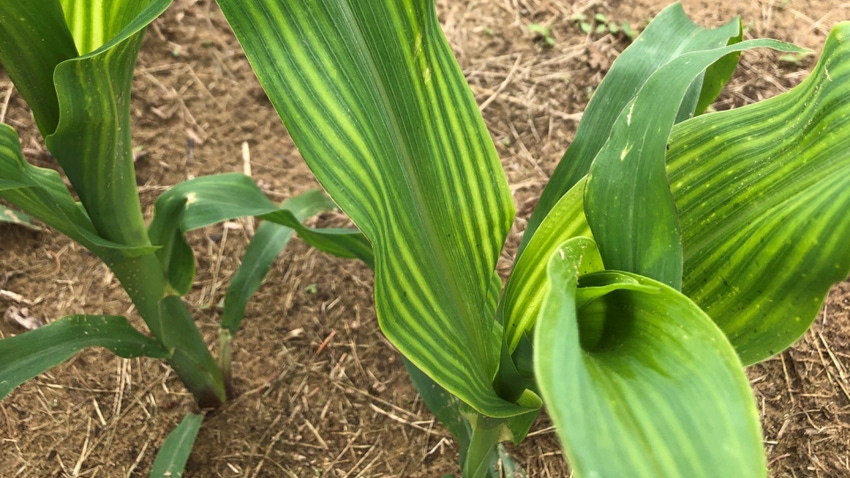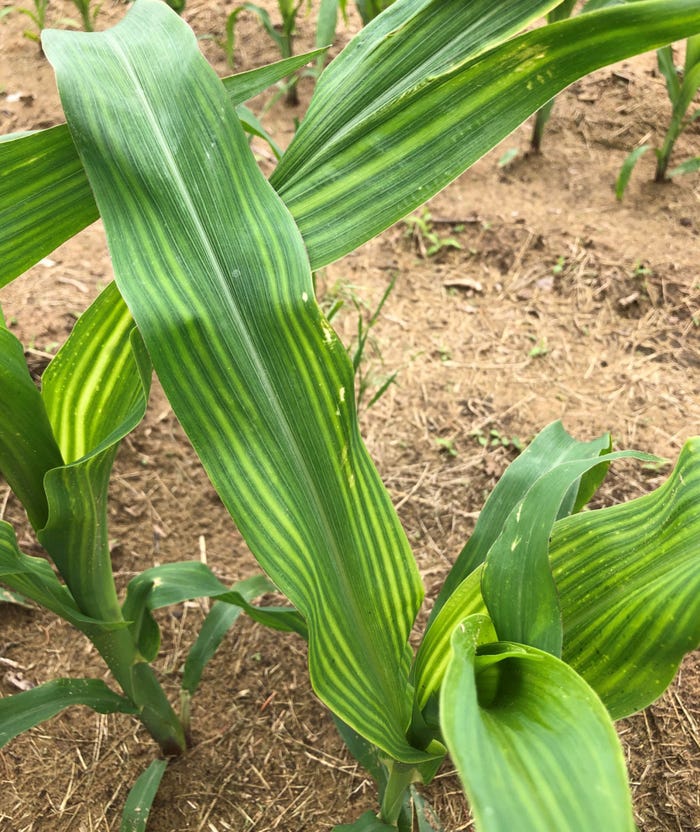May 1, 2023

Sulfur (S) is one of 17 elements essential for crop growth and ranks just below nitrogen (N), phosphorous (P), and potassium (K) in widespread soil deficiency.
Sulfur is taken up by plants as the sulfate ion (SO4 -2) and is used in the formation of amino acids, proteins, nitrogen fixation (root nodules in legumes), and chlorophyll. Increases in S deficiency symptoms observed in crops throughout the Midwest are likely attributed to higher removal rates from increased yields, a decrease in atmospheric S deposition, and declining soil health/quality.
Sulfur deficiency symptoms are often mistaken for N deficiency in young plants. In corn, interveinal yellowing from S deficiency first appears on upper/younger leaves (see right). However, yellowing from N deficiency will cover the whole leaf starting at the tip and will be on lower older leaves.

Corn Showing Sulfur Deficiency. Photo submitted by Beck's Hybrids
Sulfur is present in the soil in small amounts, the majority of which is in organic forms. Sulfur deficiency is usually linked to low organic matter, coarse-textured soils, and soils subject to leaching. Organic S is not available to the plant and must be released as sulfate by microbial mineralization. Because of its mobility, soil tests measuring sulfate (SO4) should be used in combination with organic matter levels, soil texture, and expected yield to estimate fertility quality.
Many factors should be considered for S management, including crop type, yield goal, residual S levels, annual rainfall, soil type, CEC, organic matter levels, tillage type, application methods, root depth, sulfur availability in irrigation water, and more. But, for simplicity’s sake, let's separate S fertilization into two categories: S-deficient soils and S-sufficient soils.
Soils with 2% or greater organic matter, 24% or greater root system depth, and CEC levels of 12 or higher generally have enough organic S and residual sulfate to meet the crop's seasonal requirements. But these S-sufficient fields often exhibit deficiency symptoms early in the season. Due to its tendency to leach, any available sulfate in the soil is often pushed down through the soil profile by winter precipitation and is out of reach of the root zone of a young plant.
Though the soil may have sufficient organic S, there is usually not enough microbial activity in the cool, early-season soils to mineralize and convert it into plant-available sulfate. This can also be compounded by no-till, reduced-till, and cover cropping practices, which tend to keep soil temperatures cooler, longer. In these cases, a small amount of sulfate fertilizer (5 to 10 lb./A.) applied within 2 in. of the root zone (NOT in-furrow/in contact with the seed as this will cause root injury and decreased emergence) will be sufficient to supply the plant until the soil warms and the organic S can mineralize into sulfate and become available to the plant.
In S-deficient soils (low organic matter, coarse texture, below 12 CEC), most of the S needed by the crop should be applied as fertilizer. In a corn crop, this can be 30 lb. or more, depending on the yield environment. Split-applying over two or more applications is recommended to prevent loss from individual high moisture events, which can cause leaching and loss. One pre-plant/at-planting application and one or more applications in-season during the vegetative growth stage is ideal.
It's worth noting that in irrigated areas, some irrigation water contains sufficient S to supply a crop for the season (please get your irrigation water tested at your local laboratory). In these cases, the field can be managed like the S-sufficient fields and may only need some sulfate fertilizer at the beginning of the season to get it to irrigation time.
The content of this entire article is subject to the famous agronomist’s answer to any question, "It depends." The oversimplification of dividing the entire country into two categories for a major nutrient like sulfur definitely leaves many factors out that should be considered. There is so much diversity and variability in weather and soil types alone that these methods usually have to be adjusted every 100 miles or north, south, east, and west.
Beck's - Farmers At Heart® - revolutionized the customer seed buying experience by remaining true to a foundation built on faith, family, and farming. Founded in 1937, Beck's appreciates the farmers who have helped them become the largest family-owned retail seed company and the third largest seed brand in the United States. The Beck family is now in its fifth generation of family members who work in the business to honor God and help farmers succeed. The Beck family and team of employees help farmers achieve success from generation to generation through authentic customer experiences, product diversity, seed quality, and performance. With a home office located in Atlanta, Ind., Beck's serves farmers throughout the Midwest and Mid-South. For more information about Beck's Superior Hybrids, Inc., visit www.beckshybrids.com.
You May Also Like





